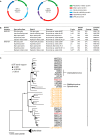Genome Sequences of Microviruses Associated with Coptotermes formosanus
- PMID: 31000548
- PMCID: PMC6473142
- DOI: 10.1128/MRA.00185-19
Genome Sequences of Microviruses Associated with Coptotermes formosanus
Abstract
Termites have a unique ability to effectively digest lignocellulose with the help of mutualistic symbionts. While gut bacteria and protozoa have been relatively well characterized in termites, the virome remains largely unexplored. Here, we report two genomes of microviruses (termite-associated microvirus-1 [TaMV-1] and termite-associated microvirus-2 [TaMV-2]) associated with the gut of Coptotermes formosanus.
Copyright © 2019 Schmidlin et al.
Figures

Similar articles
-
Metavirome Sequencing of the Termite Gut Reveals the Presence of an Unexplored Bacteriophage Community.Front Microbiol. 2018 Jan 4;8:2548. doi: 10.3389/fmicb.2017.02548. eCollection 2017. Front Microbiol. 2018. PMID: 29354098 Free PMC article.
-
Elucidating the structure, and composition of bacterial symbionts in the gut regions of wood-feeding termite, Coptotermes formosanus and their functional profile towards lignocellulolytic systems.Front Microbiol. 2024 May 22;15:1395568. doi: 10.3389/fmicb.2024.1395568. eCollection 2024. Front Microbiol. 2024. PMID: 38846576 Free PMC article.
-
Dual origin of gut proteases in Formosan subterranean termites (Coptotermes formosanus Shiraki) (Isoptera: Rhinotermitidae).Comp Biochem Physiol A Mol Integr Physiol. 2011 Jul;159(3):261-7. doi: 10.1016/j.cbpa.2011.03.012. Epub 2011 Apr 2. Comp Biochem Physiol A Mol Integr Physiol. 2011. PMID: 21440662
-
Prospects for the biological control of subterranean termites (Isoptera: rhinotermitidae), with special reference to Coptotermes formosanus.Bull Entomol Res. 2000 Feb;90(1):9-21. Bull Entomol Res. 2000. PMID: 10948359 Review.
-
Microviruses: A World Beyond phiX174.Annu Rev Virol. 2023 Sep 29;10(1):99-118. doi: 10.1146/annurev-virology-100120-011239. Annu Rev Virol. 2023. PMID: 37774127 Review.
Cited by
-
Genome Sequences of Microviruses Identified in a Sample from a Sewage Treatment Oxidation Pond.Microbiol Resour Announc. 2021 May 13;10(19):e00373-21. doi: 10.1128/MRA.00373-21. Microbiol Resour Announc. 2021. PMID: 33986100 Free PMC article.
-
Unravelling the Single-Stranded DNA Virome of the New Zealand Blackfly.Viruses. 2019 Jun 8;11(6):532. doi: 10.3390/v11060532. Viruses. 2019. PMID: 31181730 Free PMC article.
-
Genome Sequences of Microviruses Identified in Gila Monster Feces.Microbiol Resour Announc. 2021 Mar 18;10(11):e00163-21. doi: 10.1128/MRA.00163-21. Microbiol Resour Announc. 2021. PMID: 33737363 Free PMC article.
References
LinkOut - more resources
Full Text Sources
